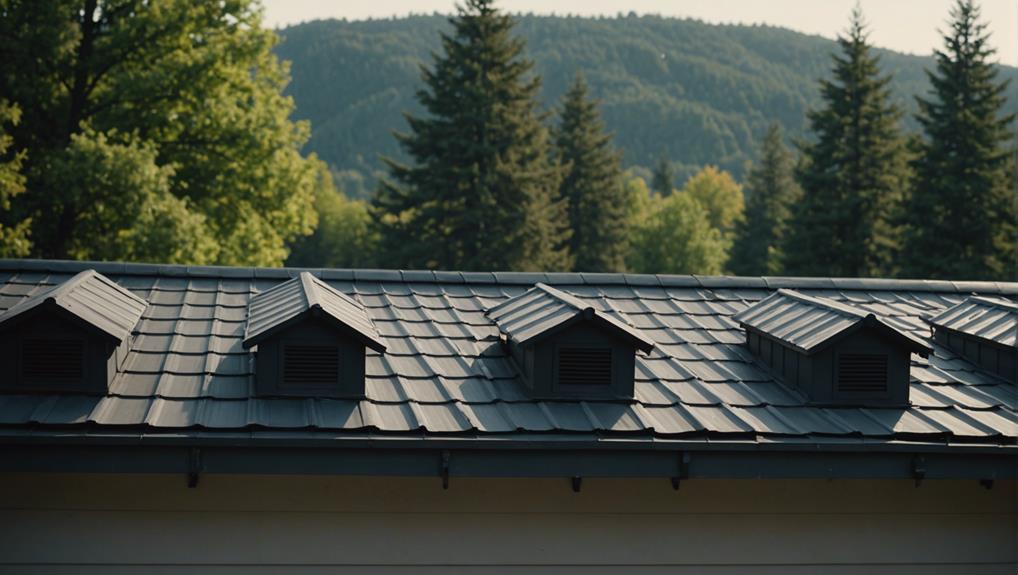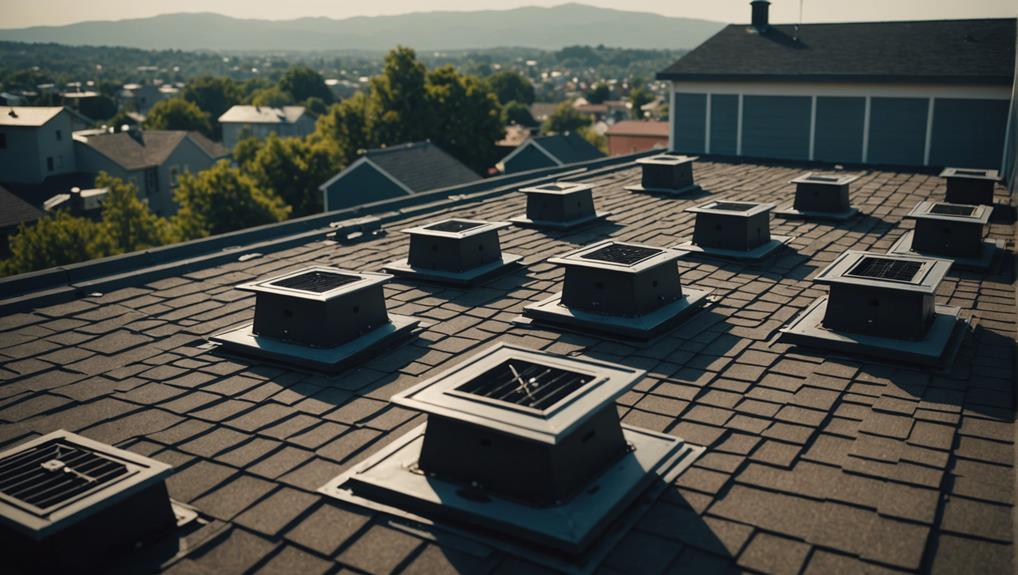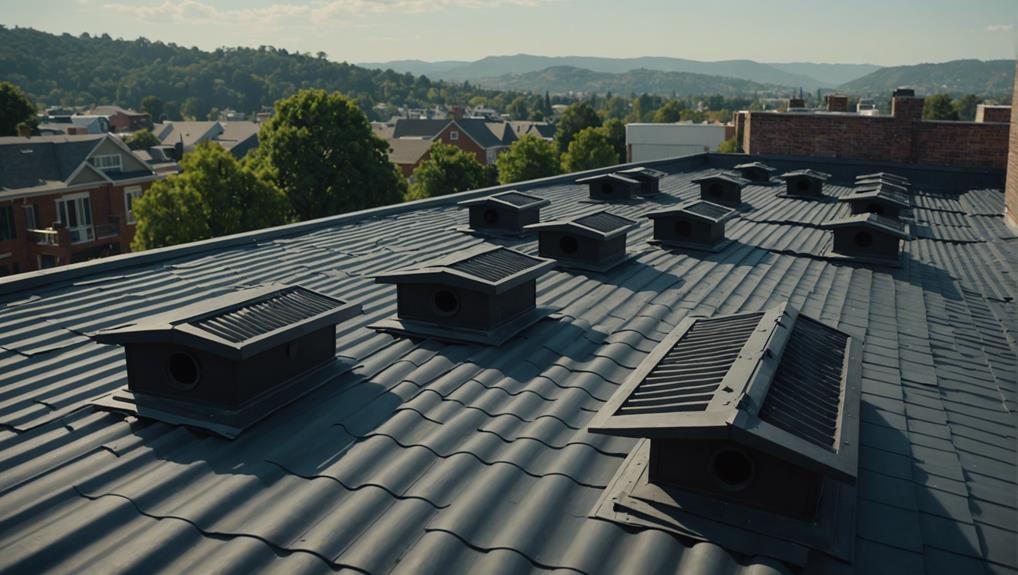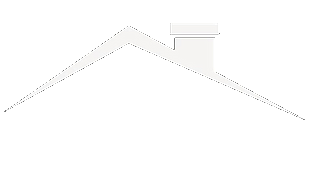When it comes to deciding where to place roof vents, it's like orchestrating a symphony of airflow above your head. The precision of their placement can have a substantial impact on the harmony within your attic space. But, where exactly should these vents be situated to guarantee peak ventilation performance? Let's explore the art of strategic vent positioning and how it can enhance your home's overall comfort and structural well-being.
Key Takeaways
- Place intake vents at the lowest points for fresh air entry.
- Position exhaust vents at the highest points for hot air and moisture escape.
- Optimal placement ensures balanced airflow and prevents circulation issues.
- Seek professional consultation for correct vent direction and placement.
- Proper vent types and installation techniques enhance airflow efficiency.
Importance of Proper Roof Vent Placement
Ensuring proper placement of roof vents is essential for optimizing airflow efficiency in attic ventilation systems. The roof structure plays a vital role in the functionality of the ventilation system.
Intake vents should be strategically located at the lowest points of the roof to allow fresh air to enter the attic space. This placement ensures a continuous flow of cool air circulating through the attic, preventing the buildup of heat and moisture.
On the other hand, exhaust vents need to be positioned at the highest points on the roof to facilitate the escape of hot air, moisture, and other pollutants from the attic. This balanced placement of intake and exhaust vents is important for maintaining proper ventilation and avoiding issues such as poor air circulation, moisture accumulation, and decreased energy efficiency.
Near the Peak for Efficient Airflow
Positioning roof vents near the peak of the roof is vital for maximizing airflow efficiency within the attic ventilation system. Placing vents high up allows hot air to escape easily, creating a natural airflow that helps regulate attic temperatures and prevent moisture buildup. Efficient airflow near the peak promotes better air circulation throughout the attic space, ensuring a balanced ventilation system for the entire roof structure.
To visually represent the importance of placing roof vents near the peak, consider the following table:
| Aspect | Importance |
|---|---|
| Hot Air Escape | Allows hot air to rise and exit effectively |
| Airflow Regulation | Regulates attic temperatures |
| Moisture Control | Prevents moisture buildup in the attic space |
| Balanced Ventilation | Ensures even airflow throughout the attic |
| Roof Structure | Maintains the integrity of the roof structure |
Placing roof vents near the peak is essential for ensuring proper ventilation and maintaining a healthy attic environment.
Avoiding Common Vent Placement Mistakes

To maintain ideal airflow balance and prevent ventilation issues, be cautious of common mistakes in the placement of roof vents. Placing intake vents too high disrupts the balance of airflow within the attic space, potentially leading to ventilation issues. Exhaust vents should be strategically positioned at the highest point on the roof to facilitate efficient air circulation and prevent the buildup of hot air. Mixing different types of exhaust vents in the same attic area can result in short-circuiting airflow, diminishing the effectiveness of the ventilation system.
Incorrectly cutting ridge vent openings can also disrupt the ventilation system's balance and hinder its overall performance. Additionally, clogged or blocked intake vents can gradually become ineffective over time, impacting the entire ventilation system's functionality. Ensuring proper placement of vents and avoiding these common vent placement mistakes is essential for maintaining a well-functioning ventilation system and promoting optimal airflow throughout the attic space.
Optimal Placement for Attic Ventilation
For efficient attic ventilation, strategically placing intake vents at the lowest point of the roof allows for the best fresh air intake. This placement ensures that cooler air from outside enters the attic, pushing out any warm air that rises.
Pairing intake vents at the lowest point with exhaust vents at the highest point of the roof creates a balanced ventilation system. This setup facilitates the flow of air, preventing moisture buildup and condensation issues within the attic space.
By regulating the attic temperature effectively, proper placement of vents not only enhances comfort but also helps extend the lifespan of the roof by reducing the risk of damage caused by excessive heat or moisture.
Ensuring the intake vents are correctly positioned is pivotal for the overall performance of the ventilation system and the well-being of the attic space. Proper placement of both intake and exhaust vents is key to maintaining a healthy and efficient attic ventilation system.
Strategic Roof Vent Positioning Tips

Consider strategically situating roof vents to optimize airflow and enhance attic ventilation efficiency.
- Place intake vents at the lowest point of the roof to allow cool air to enter the attic efficiently.
- Position exhaust vents at the highest point on the roof to facilitate the escape of hot air and moisture.
- Opt for one type of exhaust vent that meets the required net free vent area for balanced airflow.
- Match the size of the ridge vent opening with the necessary exhaust net free vent area for proper ventilation.
Key Factors in Roof Vent Placement
When strategically situating roof vents, prioritize placing them at the highest point on the roof to maximize the efficient exhaust of hot air and moisture. Soffit vents play an important role in providing fresh air intake to support the ventilation system. Proper placement of roof vents, such as ridge vents, gable vents, and turbine vents, is essential for ensuring ideal airflow and ventilation efficiency. By incorporating intake vents like soffit vents at the lower parts of the roof and exhaust vents such as ridge vents at the top, a balanced ventilation system can be achieved, allowing for continuous air circulation. This setup prevents heat buildup, reduces energy costs, and prolongs the lifespan of the roof. Consulting with a professional can help determine the correct direction and placement of roof vents to maximize the effectiveness of the ventilation system.
| Vent Type | Location | Function |
|---|---|---|
| Soffit vents | Around the roof line | Provide fresh air intake |
| Ridge vents | Top of the roof | Facilitate efficient exhaust |
| Gable vents | Sides of the roof | Assist in airflow |
Best Practices for Roof Vent Locations

To optimize roof vent locations effectively, prioritize situating them near the peak of the roof for efficient exhaust ventilation. Proper placement of vents is essential to guarantee a balanced airflow within the attic space.
Here are some best practices for roof vent locations:
- Ridge Vents: Install ridge vents along the peak of the roof to allow warm, moist air to escape from the attic efficiently.
- Gable Vents: Place gable vents on the side walls of the attic to promote cross-ventilation and prevent condensation buildup.
- Turbine Vents: Consider installing turbine vents to enhance ventilation by utilizing wind power to draw out hot air from the attic.
- Soffit Vents: Incorporate soffit vents along the eaves to facilitate the intake of fresh air, creating a continuous flow of air from the soffit to the peak vents.
Ensuring Effective Roof Vent Placement
To guarantee effective roof vent placement, concentrate on ideal vent locations near the roof's peak and along the soffits for balanced ventilation.
Utilize various types of roof vents like ridge vents, gable vents, turbine vents, and solar-powered vents strategically to enhance airflow.
Implement proper installation techniques to regulate attic temperature and prevent moisture issues, maximizing the overall ventilation efficiency.
Optimal Vent Locations
For effective roof vent placement, prioritize positioning intake vents at the lowest point on the roof to allow fresh air entry into the attic. This strategic placement guarantees maximum airflow and ventilation efficiency.
To achieve the best results, consider the following:
- Exhaust Vents: Place exhaust vents at the highest point of the roof to facilitate the release of hot, moist air.
- Balanced Ventilation System: Maintain a balanced ventilation system by combining intake and exhaust vents effectively.
- Airflow Pattern: Ensure a consistent airflow pattern by strategically placing vents to prevent issues like condensation and heat buildup.
- Consultation: Seek professional consultation to determine the optimal locations for roof vents based on your specific roof structure and local climate conditions.
Types of Roof Vents
Successful roof vent placement depends on the selection and positioning of various types of roof vents to guarantee excellent ventilation and air circulation in the attic. Different types of roof vents, such as ridge vents, soffit vents, gable vents, turbine vents, and solar-powered vents, play key roles in maintaining a well-ventilated attic space.
Ridge vents run along the peak of the roof, allowing warm air to escape, while soffit vents provide essential fresh air intake along the roof line. Gable vents are typically placed on the gable ends of the roof to promote air circulation. Turbine vents and solar-powered vents are effective options for enhancing the overall ventilation system.
Choosing the right mix of these roof vents and strategically placing them ensures optimal air circulation throughout the attic.
Proper Installation Techniques
Placement of roof vents demands meticulous attention to detail to guarantee excellent ventilation and air circulation throughout the attic space. When installing roof vents, follow these techniques to guarantee effectiveness:
- Place intake vents at the lowest point of the roof to facilitate efficient air intake.
- Position exhaust vents at the highest point on the roof to allow the escape of hot air.
- Match the ridge air slot opening with the required exhaust Net Free Ventilation Area (NFVA) for balanced ventilation.
- Prevent installation errors like clogged intake vents or inadequate airflow to maintain peak airflow in the roof ventilation system.
Frequently Asked Questions
Where Is the Best Place to Put Roof Vents?
When optimizing attic ventilation, guarantee proper installation. Explore various ventilation options like ridge, soffit, gable, turbine, and solar-powered vents. Locate vents strategically near the peak for efficient roof ventilation. Correct vent placement enhances overall venting solutions.
What Is the Rule for Roof Vents?
For proper ventilation, follow guidelines on roof vent placement. Position intake vents low on the roof and exhaust vents high. This setup guarantees effective venting, prevents issues like moisture buildup, and maintains a balanced system for peak performance.
Where Should Exhaust Vents Be Placed on a Roof?
For proper ventilation, exhaust vents must be strategically placed at a roof's peak to optimize airflow. Common mistakes in vent placement can lead to moisture issues. Follow roofing tips for ideal vent location to reap ventilation benefits efficiently.
How Many Air Vents Should a Roof Have?
To guarantee proper ventilation, consider ventilation requirements for your roof. Calculate roof venting needs based on attic space and vapor barriers. Evenly distribute vents for effective ventilation design. Attic ventilation offers many benefits for your home.
Conclusion
To sum up, proper placement of roof vents is crucial for maintaining a well-balanced attic ventilation system.
For instance, a homeowner in a hot climate enhanced their attic airflow by installing ridge vents near the peak and soffit vents at the lowest points.
By following strategic positioning tips and best practices, you can guarantee effective roof vent placement to regulate temperatures, control moisture, and enhance energy efficiency in your home.
Seek advice from professionals for expert guidance on optimizing your ventilation system.



